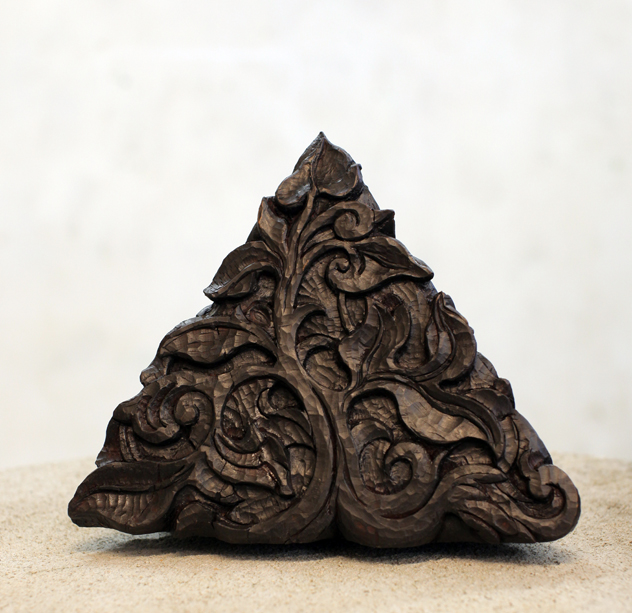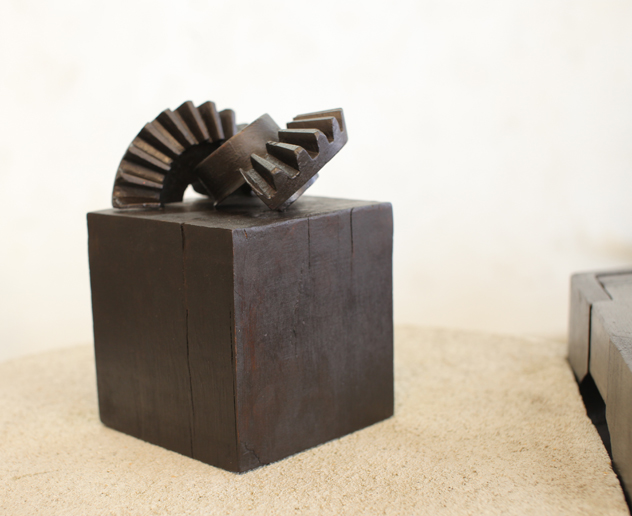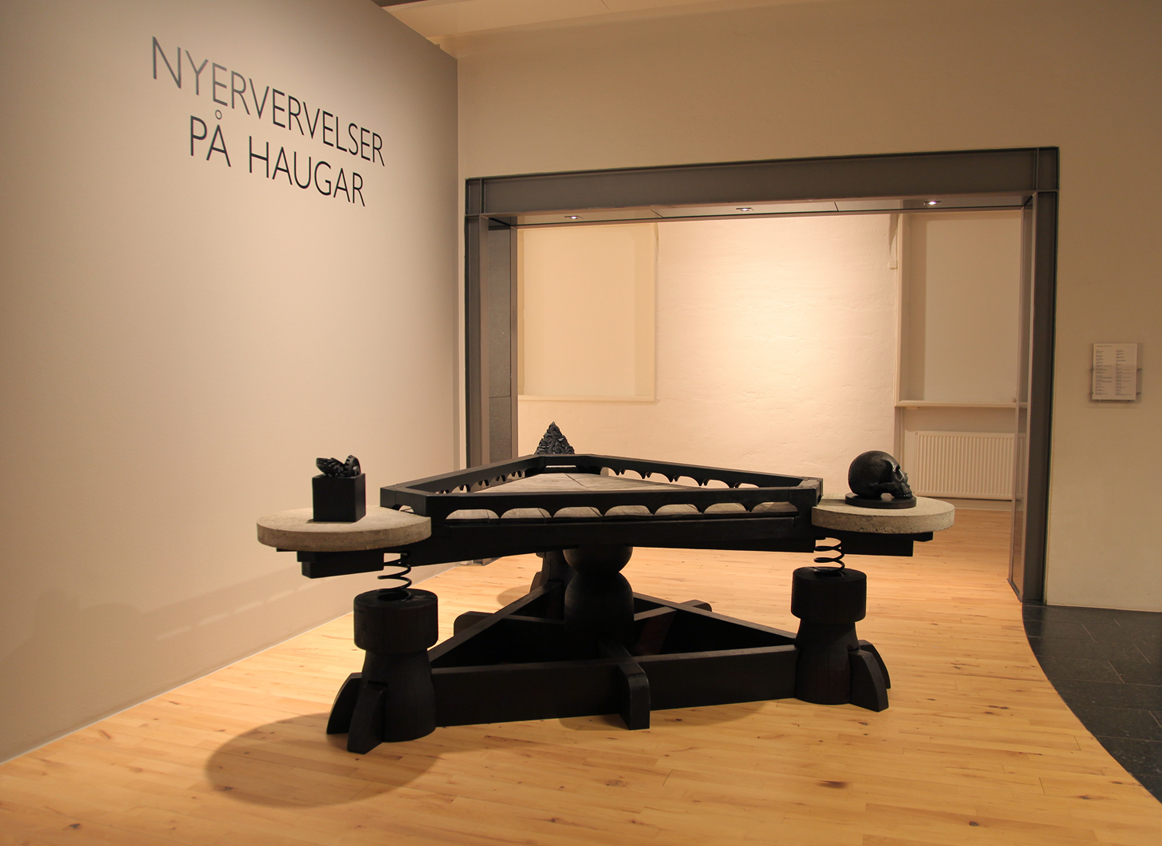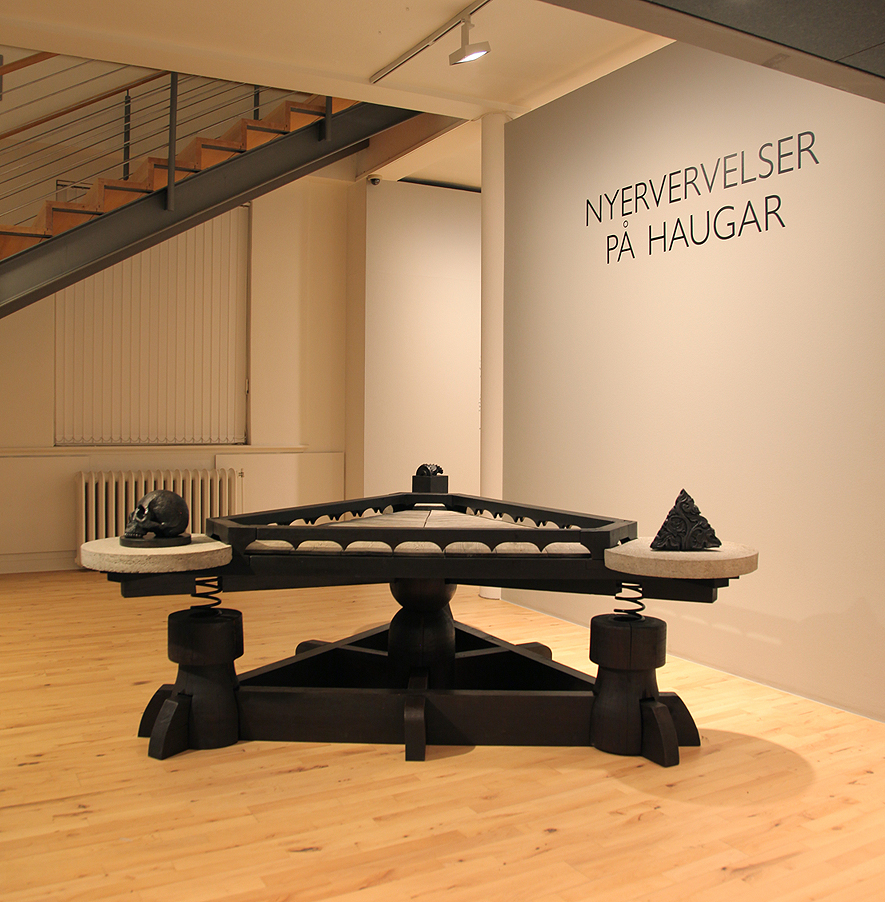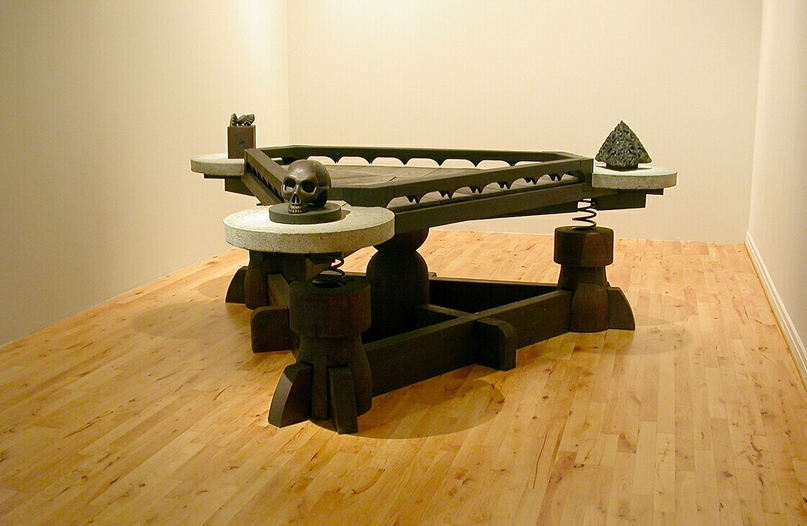"Grind"
Innkjøpt av Haugar Vestfold Kunstmuseum 2021
Purchased by Haugar Vestfold Art Museum 2021
Produksjonsår år: 1991. Størrelse: ca 240cm x 240cm x 100cm
|
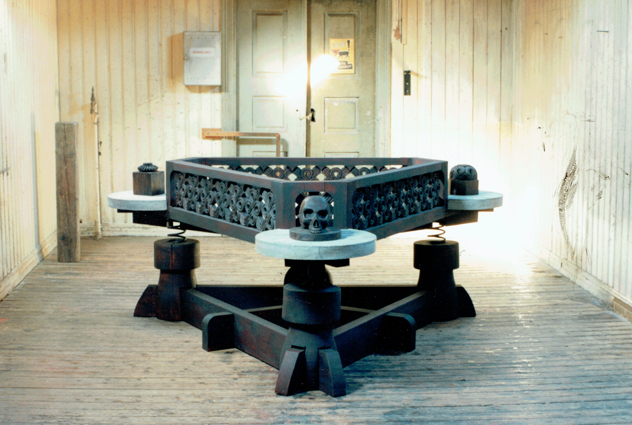
Year of production year: 1991. Materials: Wood, Concrete and steel springs. The construction is of pine, the skull is of oak while the round plinth on which the skull is mounted is of ash, the gear model (casting model) is of birch while the small cubic plinth on which it is mounted is of oak, and the tetrahedron is of apple wood. Size: ca 240cm x 240cm x 100cm |
| Historikk og bakgrunn for idé: “Grind” ble først laget til en utstilling i Galleri unge norske kunstnere i Oslo i 1991. Det ene gallerirommet var trekantet og derfor ønsket jeg å bygge en skulptur som ville være tilpasset dette rommet som hånd i hanske. Harald Flor, Dagbladets anmelder i 1991 skriver om utstillingen: “Grind” heter den enorme alter/bord-liknende konstruksjonen i det første rommet. En trekantet, streng ornamental inngjerding på kraftige bein. På hvert av hjørnene en rund betongplate med et treskurd fragment, en utskåren skalle og et borehode i samme materiale. en trio av tidssymboler. Det hele er tungt, statisk . De innmonterte stålfjærene bare forsterker det urørlige preget – ubøyelig.” På tidspunktet hvor jeg laget skulpturen skrev jeg i min notatbok: “Med treenighet som tema konstruerte jeg denne skulpturen. Det finnes mange ulike treenigheter innen blandt annet religion og filosofi. Jeg har dannet en syntese av for eksempel den egyptiske treenighet: Ånd, hjerte og tunge, den greske: Nous (intellekt) – eros (kjærlighet) – logos (kunnskap), eller Kants: kunnskap, samvittighet og vilje. Jeg har med skulpturen laget en intrikat ”sokkel” som består av 96 løse biter satt sammen til en “knute”. Sokkelen har en oppbygning med klare paralleller til gammel norsk byggekunst. Skulpturen er delt i to hoveddeler: fot og platå som er adskilt med stålfjærer. Grunnen til at mine skulpturer er sammensatt av løse deler er av praktisk og idemessig betydning. At noe er bevegelig innenfor sin gitte grense er et prinsipp for soliditet. Følelsen av samspill mellom de individuelle delene er tiltalende» |

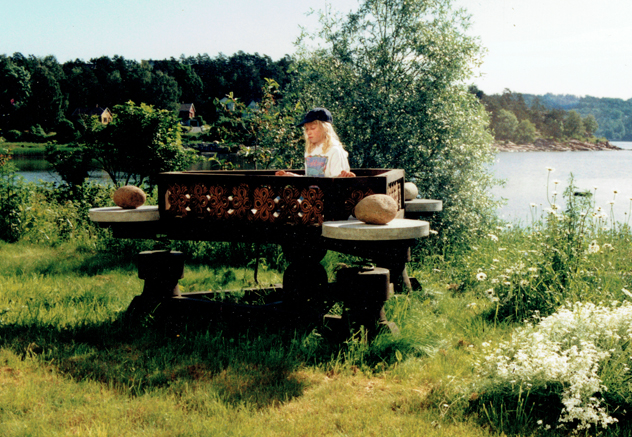
| History and intention for the sculpture: "Grind" was first made for an exhibition in the "Gallery of Young Norwegian Artists" in Oslo in 1991. One gallery room was triangular and therefore I wanted to build a sculpture that would fit perfectly to this room like a hand in a glov. Harald Flor, Dagbladet's reviewer in 1991, writes about the exhibition: "Grind" is the name of the huge altar / table-like construction in the first room. A triangular, strict ornamental fence on strong legs. On each of the corners a round concrete slab with a wood-cut fragment, a carved skull and a drill head in the same material. a trio of time symbols. It's all heavy, static. The mounted steel springs only enhance the immovable feeling - inflexible. " At the time I made the sculpture, I wrote in my notebook: “With trinity as the theme, I constructed this sculpture. There are many different trinities in, among other things, religion and philosophy. I have formed a synthesis of, for example, the Egyptian trinity: Spirit, heart and tongue, the Greek: Nous (intellect) - eros (love) - logos (knowledge), or Kants: knowledge, conscience and will. With the sculpture I have made an intricate "plinth" which consists of 96 loose pieces put together into a "knot". The shelf has a structure with clear parallels to old Norwegian architecture. The sculpture is divided into two main parts: foot and plateau which are separated by steel springs. The reason why my sculptures are composed of loose parts is of practical and ideological significance. That something is movable within its given limit is a principle of solidity. The feeling of interaction between the individual parts is appealing » |
Jeg har alltid vært opptatt av musikk og bruker musikk som inspirasjon når jeg arbeider. Tittelen «Grind» refererer til det norrøne ordet grind av betydningen sprinkelverk som fungerer som karm eller gjerde rundt noe, en port,en innhegning eller stavkonstruksjonen inne i stavkirkene. I naturen finnes ingen ren geometri. Geometrien viser seg fra ett gitt punkt – en gitt avstand og opphører når man fokuserer på detaljene. Ren geometri er en imaginal størrelse. Ren geometri eksisterer kun i menneskenes forestillingsverden – i tallenes og tegnenes verden – i representasjonen. |
| Fra utstillingen på Haugar 2004 |
|
I have always been interested in music and I use music as inspiration when I work. In 1991, I was interested in what was then known as Speed and Trash metal and especially bands such as Swiss Celtic Frost and Coroner. This was probably also important for the design of "Grind". Both Celtic Frost and Coroner had references to symbol-heavy sculptures on their record covers and used geometric symbols on labels and inner sleeves. The title "Grind" refers to the Norse word grind, meaning sprinkler that acts as a frame or a gate, a fence or the stave structure inside the stave churches. My idea was that Grind should symbolically represent the human domain, and with the three sculptures placed in each corner, the sculpture appears as an explanatory model of the basic elements of human existence: the skull = spirit (Logos), ornament = the heart (Pathos) and the gear = tongue (Ethos). Each sculpture has its own basic geometric shape; the triangle, the square and the circle. The person who seeks the objective truth often looks to mathematics and geometry to find answers. Geometry can be seen as man's ultimate and most necessary tool for building his world in materials and space. Geometry becomes the starting point for architecture and creates through this function, balance, strength and beauty. Geometry also has another important function throughout human history; geometry as religious, philosophical and political explanatory models. Symbols that work together and express the great we, which in turn gives identity and an apparent meaning to life. At the same time, the greatness we can justify oppression and terror against those who are an outsider. In nature there is no pure geometry. The geometry appears from a given perspectivt - a given distance and ceases when you focus on the details. Pure geometry is an imaginal quantity. Pure geometry exists only in the imaginary world of human beings - in the world of numbers and signs - in representation. |
"Grind" har vært utstilt kun tre ganger;, i galleri Unge Norske Kunstnere i 1991, Drammen kunstforening i 1994 (da hadde skulpturen tittelen: "Folly") og på Haugar Kunstmuseum i 2004. Til utstillingen på Haugar ble skulpturen endret. Den ornamenterte innrammingen av skulpturen ble fjernet og et av symbolene ble erstattet av en tetraeder. Etter å ha ligget 17 år på mitt lager trengte skulpturen en total renovering. Noen deler måtte erstattes med nye og hver del ble bedre tilpasset hverandre. Skallen hadde blitt stjålet under et innbrudd i mitt lager og måtte derfor lages på nytt. Tetraederen måtte også lages på nytt da den opprinnelige var gitt bort i gave. Hele skulpturen fikk ny patina Åsmund Thorkildsen skriver i Drammens Tidene om utstilling i Drammens Kunstforening 1994: "Øien henter sine fragmenter fra norsk treskurd, fra gammel norsk byggeskikk (stabbursokler), rekved, gipsornamenter og kjøretøysteknologi (bilfjærer og akslinger). Som mye postmoderne kunst, blir sammenstillingen absurd: maskinene har tilsynelatende ingen funksjon, ting settes sammen løsrevet fra sin "Sitz im Leben" og det åpnes for en fri fabulerende diktning, som ingen behøver å stå til regnskap for. Én mulig tolkning er at det gamles møte med det nye (og byens møte med bygda) ikke riktig funksjonerer som teknikk ("fremskritt") men bare som råvarer til fabulering. Styrken ved Øiens arbeider denne gangen er nettopp denne lekende evnen til å lage noe som er dekorativt og fantasieggende, og han begynner å finne frem til en presisjon i utførelsen som gjør tingene troverdige. Ennå er det den idémessige siden som er det viktigste (for treskurden er mer laget enn skåret). Det er også et godt tegn at kunstneren er klar over det vidløftige i et slik prosjket, i og med at han kaller et av arbeidene "Folly" (Grind). Folly betyr som kjent både noe som er litt tåpelig og ubrukelig, samtidig som det er genrebetegnelsen på 1700-tallets overflødige, men dekorative hagebygninger. |
Fra restaureringen av "Grind" 2021 |
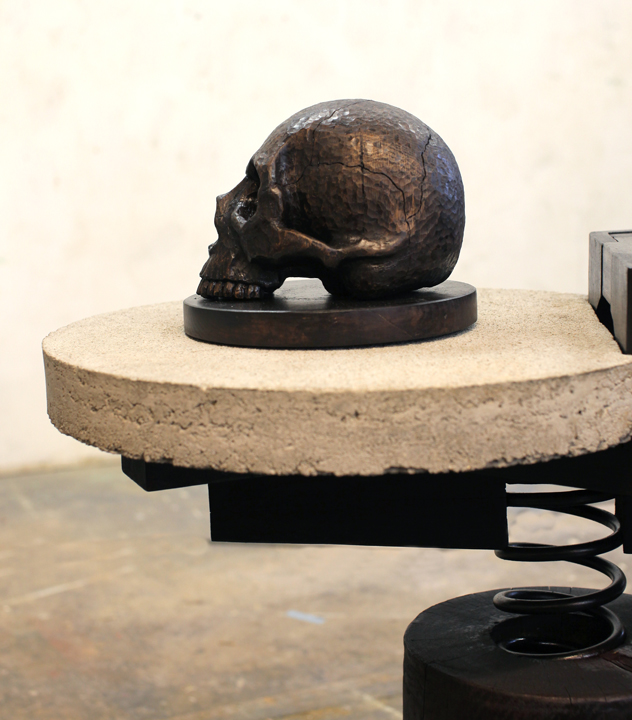
"Grind" has been exhibited only three times. First time in the Galleri Unge Norske Kunstnere in Oslo, 1991. Then Drammen kunstforening in 1994 (then the sculpture had the title: "Folly") and at Haugar Kunstmuseum in 2004. For the exhibition at Haugar, the sculpture was changed. The ornate framing of the sculpture was removed and one of the symbols was replaced by a tetrahedron. After being in my warehouse for 17 years, the sculpture needed a complete renovation. Some parts had to be replaced with new ones and each part was better adapted to each other. The skull had been stolen during a burglary in my warehouse and therefore had to be made again. The tetrahedron also had to be made again when the original was given away as a gift. The whole sculpture got a new patina Åsmund Thorkildsen writes in Drammens Tidene about the exhibition in Drammens Kunstforening 1994: "Øien draws its fragments from Norwegian woodcuts, from old Norwegian building customs (loft feet), driftwood, plaster ornaments and vehicle technology (car springs and axles). Like much postmodern art, the compilation is absurd: the machines seem to have no function, things are put together detached from their "Sitz im Leben" and it opens up for a free imaginative poetry, for which no one needs to be held accountable.One possible interpretation is that the old meets the new (and the city meets with the village) does not properly function as a technique ("progress") but only as raw materials for fabrication.The strength of Øien's work this time is precisely this playful ability to create something that is decorative and imaginative, and he begins to find a precision in the execution that makes things credible. Yet it is the ideological side that is most important (for the woodcut is more made than the cut) .It is also a good sign that the artist is aware of the ambiguity of such a project, in that he calls one of the works "Folly" (Grind). Folly is known to mean both something that is a bit silly and useless, at the same time as it is the genre designation of the 18th century's superfluous but decorative garden buildings. |
